Advanced Machine Learning Functionalities in the Medium Voltage Distributed Monitoring System QuEEN: A Macro-Regional Voltage Dips Severity Analysis
Abstract
1. Introduction
2. The QuEEN Monitoring System
- North-West (NW)
- North-East (NE)
- Center-Sardinia (CS)
- South (S).
- Voltage Variations
- Voltage Unbalances
- Voltage Harmonics
- Flicker
- Rapid Voltage Changes
- Voltage Dips
- Voltage Swells
- Interruptions
- Validity
- Origin
2.1. Validity Criterion Based on 2nd Harmonic
- the occurrence of a threshold overcoming for the 2nd harmonic level (fixed to a given percent of the rms value)
- the succession of a minimum number of consecutive exceedances of the 2nd harmonic threshold.
2.2. Origin Criterion Based on HV Protections and Events Correlation
- A fault occurred in the transmission grid (HV fault), namely an upstream event; the associated voltage dip has to be attributed to the TSO responsibility;
- A fault occurred in the distribution grid (MV fault), namely a downstream event; the associated voltage dip has to be attributed to the DSO responsibility.
- Detection of True voltage dips associated with the start signal of the distance protection installed on the HV side of the PS (HV Distance Protection events); this functionality is achieved directly by the MU by means of a digital input channel;
- Detection of others True voltage dips that meet the following two conditions:
- о
- VDs having “coincident” time of occurrence, within a certain tolerance range, with the events previously identified (HV Occurrence Events);
- о
- VDs having “coincident” time of occurrence between them, within a certain tolerance range, and being recorded by MUs belonging to PSs underlying a common HV grid (HV Correlated Events).
3. Machine Learning and Deep Learning Techniques in the QuEEN Monitoring System
3.1. DELFI—Deep Learning for False Events Identification
- 80%-10%-10% input data partitioning into the Training Set, the Development Set and the Test Set respectively (input data equal to 1300 image events);
- Bayesian optimization (BO) [37] was adopted to assess the model hyper-parameters;
- Softmax algorithm was used as a classifier.
3.2. FExWaveS Application—Features Extraction from Waveform Segmentation
- A segmentation algorithm aimed to estimate a “shape factor”;
- Support Vector Machine classifier whose input features are the dip duration, its residual voltage, the number of line-to-line voltages involved and the shape factor. The output label of the classifier is the voltage dip origin (HV or MV).
- Number of transient segments;
- Duration of the steady-state segments.
- Rectangular;
- Smooth Rectangular;
- Not Rectangular;
- Multistage Rectangular;
- Multistage Smooth Rectangular.
3.3. QuEEN PyService Application
- QuEEN Services: functionalities that directly manages a set of data stored in the QuEEN database regarding voltage dips, that means:
- о
- MU identification code;
- о
- start and stop event time stamps;
- о
- VD residual voltage;
- о
- VD duration;
- о
- QuEEN validity criterion output (2nd harmonic algorithm);
- о
- QuEEN origin criterion output (Global Method);
- о
- Occurrence of a distance protection start signal with the voltage dip;
- о
- Generation of an archive of images representing the rms values associated with each event.
- Advanced Services: functionalities that integrate advanced applications namely DELFI and FExWaveS applications. The following operations are performed:
- о
- Application of the DELFI classifier for validity assessment: the system for each generated image performs the DL algorithm and stores the outcome, making it possible to compare the DELFI classifier outcomes with respect to those of the 2nd harmonic criterion.
- о
- Application of the FExWaveS classifier for origin assessment, applying the following procedure:
- ■
- If there is a concomitant occurrence of the distance protection start signal associated with the considered VD, the event is automatically classified as HV;
- ■
- If it is not, QuEEN PyService activates the FExWaveS application, applying the algorithm presented in Section 3.2. In both cases, the outcome is stored for comparison with that of the Global Method.
4. Validity and Origin Assessment: Comparison between Current and New Techniques
- Current criteria:
- о
- Second harmonic criterion (validity).
- о
- Global Method (origin).
- New criteria:
- о
- DELFI (validity).
- о
- FExWaveS (origin).
4.1. Validity Assessments Comparison
- The rows show the results of the DELFI criterion;
- The columns refer to the outcomes of the 2nd harmonic criterion.
4.2. Origin Assessments Comparison
4.3. Voltage Dips Duration Frequency Histograms
5. Severity Analysis
- Current Criteria:
- о
- Evaluation of True Voltage Dips adopting the 2nd harmonic criterion;
- о
- Computation of N2a and N3b;
- о
- Identification of the contributions of HV and MV origin through the Global Method.
- New Criteria:
- о
- Evaluation of True Voltage Dips adopting the DELFI criterion;
- о
- Computation of N2a and N3b;
- о
- Identification of the contributions of the HV and MV origin through the FExWaveS application.
5.1. Macro-Regional Area Analysis
- North-West (NW)
- North-Est (NE)
- Center-Sardinia (CS)
- South (S)
5.2. N2a Comparison: Current vs. New Criteria
- Considering Figure 13a,b it can be noted that the calculated N2a indices reach the highest values for the South area, with a maximum recorded in 2019 (75.3 N°/EMP and 88.5 N°/EMP for the current and new criteria); these values are practically twice the overall N2a of Table 8 (35.8 N°/EMP and 41.7 N°/EMP respectively) so that it is the South area that has the greatest weight on the global severity of the events; in fact, in 2019, the second-highest value is recorded for the CS area where N2a is equal to 29.0 N°/EMP and 33.7 N°/EMP. Looking at the comparison between current and new criteria, N2a is being enhanced for all macro-regions.
- In Figure 13c,d the trend shown for the overall results is confirmed: moreover, MV events give the greatest contribution to N2a; as an example, in 2019 the South area, reaches an N2a equal to 56.5 N°/EMP and 70.3 N°/EMP respectively for the current and the new criteria, that is, in this case, MV events contribute 75% and 79% respectively to the overall N2a for the new and current criteria respectively. As a general trend, the new criterion considerably boosts all the macro-regional areas indices for the considered time period.
- Figure 13e,f confirms what is presented in Table 10 that is, HV events contribute less to N2a. As an example, the South area in 2019 achieved an N2a equal to 18.8 N°/EMP and 18.2 N°/EMP for the current and the new criteria. In this case, the adoption of the new criterion decreases the PQ index compared to the current one. This trend is not systematic for all the macro-regional areas.
5.3. N3b Comparison: Current vs. New Criteria
- The use of the new criteria significantly increases N3b compared to N2a, showing an average growth of 33% with respect to the use of the current criteria
- Comparing Table 13 and Table 14, which refer to MV and HV events respectively, the N3b is significantly higher for MV events, according to both the adopted criteria, than for HV events; referring in particular to MV events, the average N3bs, over the considered time, is equal to 12.0 N°/EMP and 8.5 N°/EMP according to respectively the new and the current criterion while they reach 1.2 N°/EMP and 1.6 N°/EMP for the HV events. Therefore, the adoption of the new criteria reduces the HV events impact on N3b compared to the current ones.
- Considering Figure 15a,b the N3b values reach their maximum in 2019 for the South area with an N3b equal to 33.9 N°/EMP for the new criteria and 45.1 N°/EMP for the current ones. The weight of the South area with respect to the overall indices (respectively 14.8 N°/EMP and 19.5 N°/EMP) is remarkably high (more than double). The other macro-regional areas present significantly lower N3bs: as an example, the Central-Sardinia area results in 11.3 N°/EMP and 14.7 N°/EMP respectively for the current and new criterion
- In Figure 15c,d the global trend for MV events is confirmed on a macro-regional areas level: MV events are the main contribution to the overall N3bs
- Looking at Figure 15e,f the new criterion compared to the current one reduces the N3b index for HV events; an example, the South area in 2019 has achieved the values 5.7 N°/EMP and 4.5 N°/EMP respectively for the current and new criterion. This trend is systematic for all macro-regional areas: therefore, the new criteria classify a certain number of HV events for the current ones, in MV events
6. Conclusions
Author Contributions
Funding
Conflicts of Interest
References
- Bollen, M.H.J.; Das, R.; Djokic, S.; Ciufo, P.; Meyer, J.; Rönnberg, S.; Zavodam, F. Power Quality Concerns in Implementing Smart Distribution-Grid Applications. IEEE Trans. Smart Grid 2016, 8, 391–399. [Google Scholar] [CrossRef]
- European Committee for Electrotechnical Standardization. EN50160, Voltage Characteristics of Electricity Supplied by Public Electricity Networks; CENELEC: Brussels, Belgium, 2016. [Google Scholar]
- Meyer, J.; Blanco, A.; Rönnberg, S.; Bollen, M.; Smith, J. CIGRE C4/C6.29: Survey of utilities experiences on power quality issues related to solar power. CIRED—Open Access Proc. J. 2017, 1, 539–543. [Google Scholar] [CrossRef]
- Ray, K.; Mohanty, S.R.; Kishor, N. Classification of power quality disturbances due to environmental characteristics in distributed generation system. IEEE Trans. Sustain. Energy 2013, 4, 302–313. [Google Scholar] [CrossRef]
- Kattmann, C.; Rudion, K.; Tenbohlen, S. Detailed power quality measurement of electric vehicle charging infrastructure. CIRED—Open Access Proc. J. 2017, 2017, 581–584. [Google Scholar] [CrossRef][Green Version]
- Mastny, P.; Moravek, J.; Vojtek, M.; Drapela, J. Hybrid Photovoltaic Systems with Accumulation—Support for Electric Vehicle Charging. Energies 2017, 10, 834. [Google Scholar] [CrossRef]
- Bollen, M.H.J. Understanding Power Quality Problems: Voltage Sags and Interruptions; IEEE Press: New York, NY, USA, 1999. [Google Scholar]
- Mottola, F.; Proto, D.; Varilone, P.; Verde, P. Planning of Distributed Energy Storage Systems in μGrids Accounting for Voltage Dips. Energies 2020, 13, 401. [Google Scholar] [CrossRef]
- Belloni, F.; Chiumeo, R.; Gandolfi, C.; Villa, A. Performance test of a PQ universal compensator through Control Hardware in the Loop simulation. In Proceedings of the 6th International Conference on Clean Electrical Power, ICCEP 2017, Santa Margherita Ligure, Italy, 27–29 June 2017. [Google Scholar] [CrossRef]
- Sadigh, A.K.; Smedley, K.M. Review of voltage compensation methods in dynamic voltage restorer (DVR). In Proceedings of the 2012 IEEE Power and Energy Society General Meeting, San Diego, CA, USA, 22–26 July 2012; pp. 1–8. [Google Scholar] [CrossRef]
- Milanovic, J.V.; Gupta, C.P. Probabilistic Assessment of Financial Losses due to Interruptions and Voltage Sags—Part I: The Methodology. IEEE Trans. Power Deliv. 2006, 21, 918–924. [Google Scholar] [CrossRef]
- Milanovic, J.V.; Gupta, C.P. Probabilistic Assessment of Financial Losses due to Interruptions and Voltage Sags—Part II: Practical Implementation. IEEE Trans. Power Deliv. 2006, 21, 925–932. [Google Scholar] [CrossRef]
- Ding, Z.; Zhu, Y.; Chen, C. Economic loss assessment of voltage sags. In Proceedings of the CICED 2010 Proceedings, Nanjing, China, 13–16 September 2010; pp. 1–5. [Google Scholar]
- Celli, G.; Pilo, F.; Pisano, G.; Soma, G.G. Including voltage dips mitigation in cost-benefit analysis of storages. In Proceedings of the 2018 18th International Conference on Harmonics and Quality of Power (ICHQP), Ljubljana, Slovenia, 13–16 May 2018; pp. 1–6. [Google Scholar] [CrossRef]
- De Santis, M.; Di Stasio, L.; Noce, C.; Verde, P.; Varilone, P. Initial Results of an Extensive, Long-Term Study of the Forecasting of Voltage Sags. Energies 2021, 14, 1264. [Google Scholar] [CrossRef]
- D’Orazio, L.; Corsi, N.; Riva, S. Analysis of voltage dips on Italian distribution network. In Proceedings of the 2021 AEIT International Annual Conference (AEIT), Venice, Italy, 4–8 October 2021; pp. 1–6. [Google Scholar]
- Gong, X.; Yu, Y.; Wang, B.; Ye, F.; Zhou, N. A severity assessment method for multiple voltage sag. In Proceedings of the 2017 IEEE 3rd Information Technology and Mechatronics Engineering Conference (ITOEC), Chongqing, China, 3–5 October 2017; pp. 135–140. [Google Scholar] [CrossRef]
- IEEE. IEEE Guide for Voltage Sag Indices. In IEEE Std. 1564–2014; IEEE: Piscataway, NJ, USA, 2014; pp. 1–59. [Google Scholar]
- Joint Working Group CIGRE/CIRED C4110. Voltage Dip Immunity of Equipment and Installations; Report 412; Cigré: Paris, France, 2010. [Google Scholar]
- CIGRE. CIGRE/CIRED JWG C4.112-Guidelines For Power Quality Monitoring—Measurement Locations, Processing And Presentation Of Data; CIGRE: Paris, France, 2014; Available online: https://www.researchgate.net/publication/280100959_GUIDELINES_FOR_POWER_QUALITY_MONITORING_-_MEASUREMENT_LOCATIONS_PROCESSING_AND_PRESENTATION_OF_DATA_CIGRECIRED_JWG_C4112 (accessed on 4 October 2021).
- Available online: http://queen.rse-web.it/ (accessed on 4 October 2021).
- IEC 61000-4-30. Electromagnetic Compatibility (EMC)—Part 4-30: Testing and Measurement Techniques—Power Quality Measurement Methods; IEC: Geneva, Switzerland, 2015. [Google Scholar]
- AEEGSI Resolution 29 December 2011, 198/2011. Available online: https://www.arera.it/allegati/docs/11/198-11arg.pdf (accessed on 6 October 2021).
- ARERA Resolution 23 December 2019, 566/2019/R/EEL. Available online: https://www.arera.it/it/docs/19/566-19.htm (accessed on 6 October 2021).
- Chiumeo, R.; de Nigris, M.; Gandolfi, C.; Garbero, L.; Tenti, L.; Carpaneto, E. Implementation of a New Method for an Improved Voltage Dips Evaluation by the Italian Power Quality Monitoring System in Presence of VT Saturation Effects. REPQJ 2010, 1, 519–523. [Google Scholar] [CrossRef]
- Chiumeo, R.; Garbero, L.; Malegori, F.; Tenti, L. Feasible methods to evaluate voltage dips origin. REPQJ 2015, 1, 357–361. [Google Scholar] [CrossRef]
- Mishra, M. Power quality disturbance detection and classification using signal processing and soft computing techniques: A comprehensive review. Int. Trans. Electr. Energy Syst. 2019, 29, e12008. [Google Scholar] [CrossRef]
- Mahela, O.P.; Shaik, A.G.; Gupta, N. A critical review of detection and classification of power quality events. Renew. Sustain. Energy Rev. 2015, 41, 495–505. [Google Scholar] [CrossRef]
- Elbouchikhi, E.; Zia, M.F.; Benouzid, M.; El Hani, S. Overview of Signal Processing and Machine Learning for Smart Grid Condition Monitoring. Electronics 2021, 10, 2725. [Google Scholar] [CrossRef]
- Chawda, G.S.; Shaik, A.G.; Shaik, M.; Padmanaban, S.; Holm-Nielsen, J.B.; Mahela, O.P.; Kaliannan, P. Comprehensive review on detection and classification of power quality disturbances in utility grid with renewable energy penetration. IEEE Access 2020, 8, 146807–146830. [Google Scholar] [CrossRef]
- Iruansi, U.; Tapamo, J.R.; Davidson, I.E. Classification of Power-line Insulator Condition using Local Binary Patterns with Support Vector Machines. IAENG Int. J. Comput. Sci. 2019, 46, 300–310. [Google Scholar]
- Tenti, L.; Chiumeo, R.; Zanoni, M.; Shadmehr, H. Deep Learning to Assess Voltage Dips Validity. In Proceedings of the 2020 AEIT International Annual Conference (AEIT), Catania, Italy, 23–25 September 2020; pp. 1–4. [Google Scholar] [CrossRef]
- Shadmehr, H.; Chiumeo, R.; Tenti, L. Self-tuning Kalman filter and machine learning algorithms for voltage dips upstream or downstream origin detection. Distribution. Renew. Energy Power Qual. J. 2016, 19, 235–240. [Google Scholar] [CrossRef]
- Zanoni, M.; Chiumeo, R.; Tenti, L.; Volta, M. Automated Tool Based on Deep Learning to Assess Voltage Dips Validity: Integration in the QuEEN MV network Monitoring System. Renew. Energy Power Qual. J. 2021, 14, 409–413. [Google Scholar] [CrossRef]
- Zanoni, M.; Chiumeo, R.; Tenti, L.; Volta, M. FExWaveS application for voltage dips origin assessment: Optimization of the tool in views of its integration into the QuEEN monitoring system. In Proceedings of the 2021 AEIT International Annual Conference (AEIT), Venice, Italy, 4–8 October 2021; pp. 1–6. [Google Scholar]
- Zeiler, M.D.; Fergus, R. Visualizing and Understanding Convolutional Networks; Course CSCI 662 Advanced; University of Southern California: Los Angeles, CA, USA, 2013. [Google Scholar]
- Mockus, J.; Tiesis, V.; Zilinskas, A. The application of Bayesian methods for seeking the extremum. Towards Glob. Optim. 1978, 2, 117–129. [Google Scholar]
- Macias, J.A.R.; Exposito, A.G. Self-Tuning of Kalman Filter for Harmonic Computation. IEEE Trans. Power Deliv. 2006, 21, 501–503. [Google Scholar] [CrossRef]
- Montgomery, D.C. Introduction to Statistical Quality Control; John Wiley & Sons, Inc.: Hoboken, NJ, USA, 2009. [Google Scholar]
- Flach, P. Machine Learning: The Art and Science of Algorithms that Make Sense of Data; Cambridge University Press: Cambridge, UK, 2012. [Google Scholar]
- CEI EN 61000-4-11. Compatibilità elettromagnetica (EMC)—Parte 4-11: Tecniche di Prova e di Misura—Prove d’immunità a Buchi di Tensione, Brevi Interruzioni e Variazioni di Tensione; CEI: Milan, Italy, 2006. [Google Scholar]
- CEI EN 61000-4-34. Compatibilità elettromagnetica (EMC)—Parte 4-34: Tecniche di Prova e di Misura—Prove d’immunità ai Buchi di Tensione e Alle Variazioni di Tensione per le Apparecchiature con Corrente di Ingresso Superiore a 16 A per Fase; CEI: Milan, Italy, 2007. [Google Scholar]
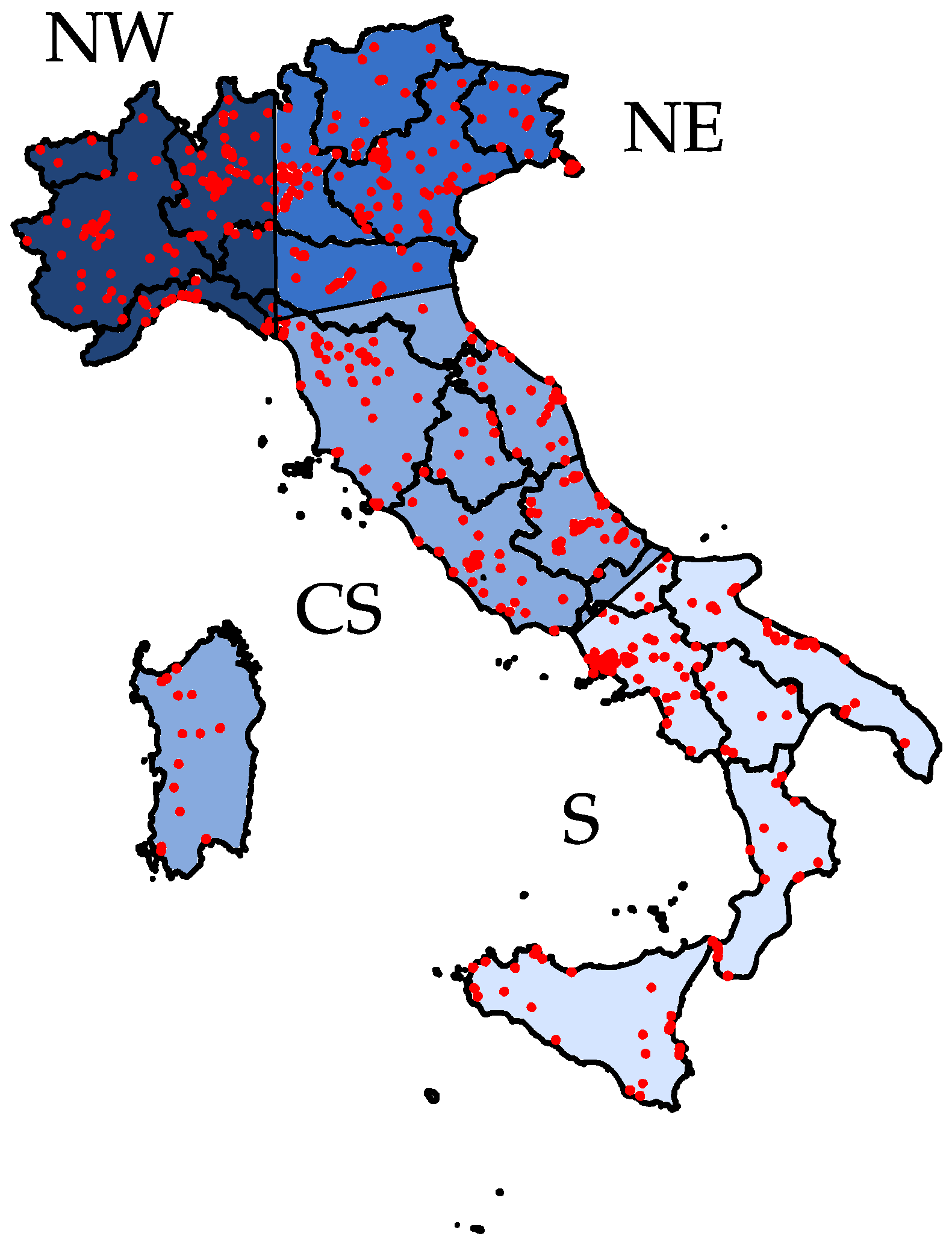
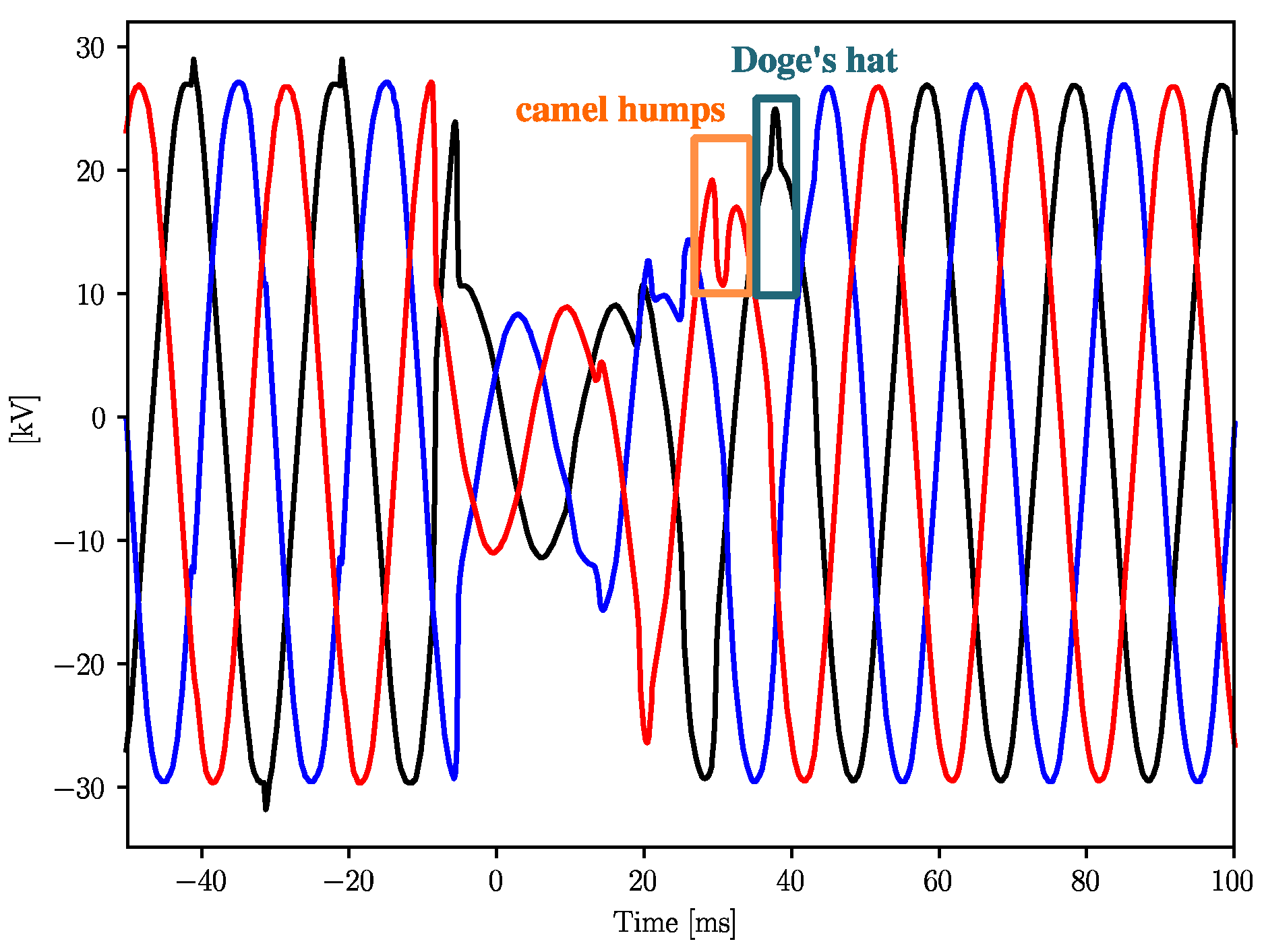

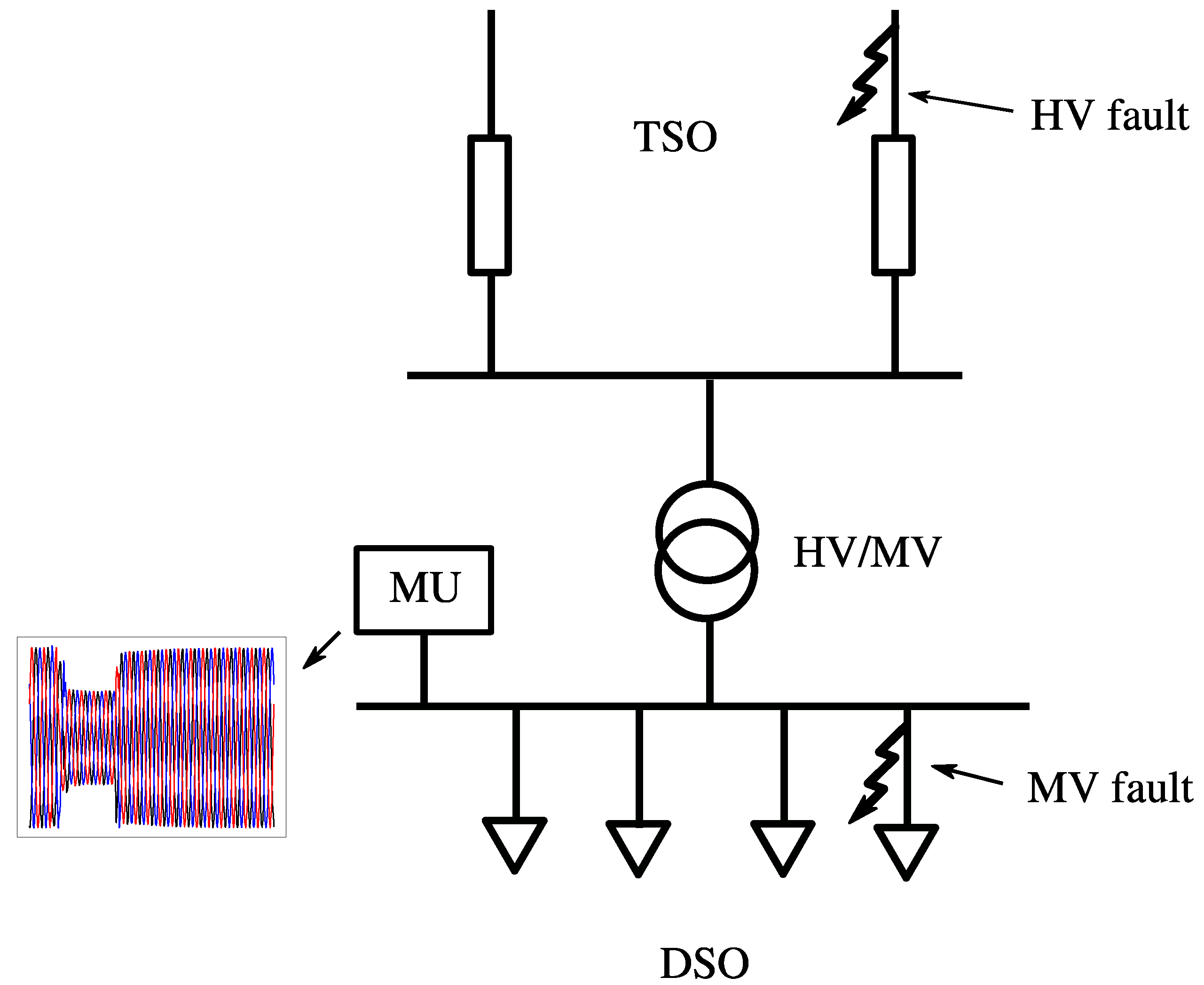


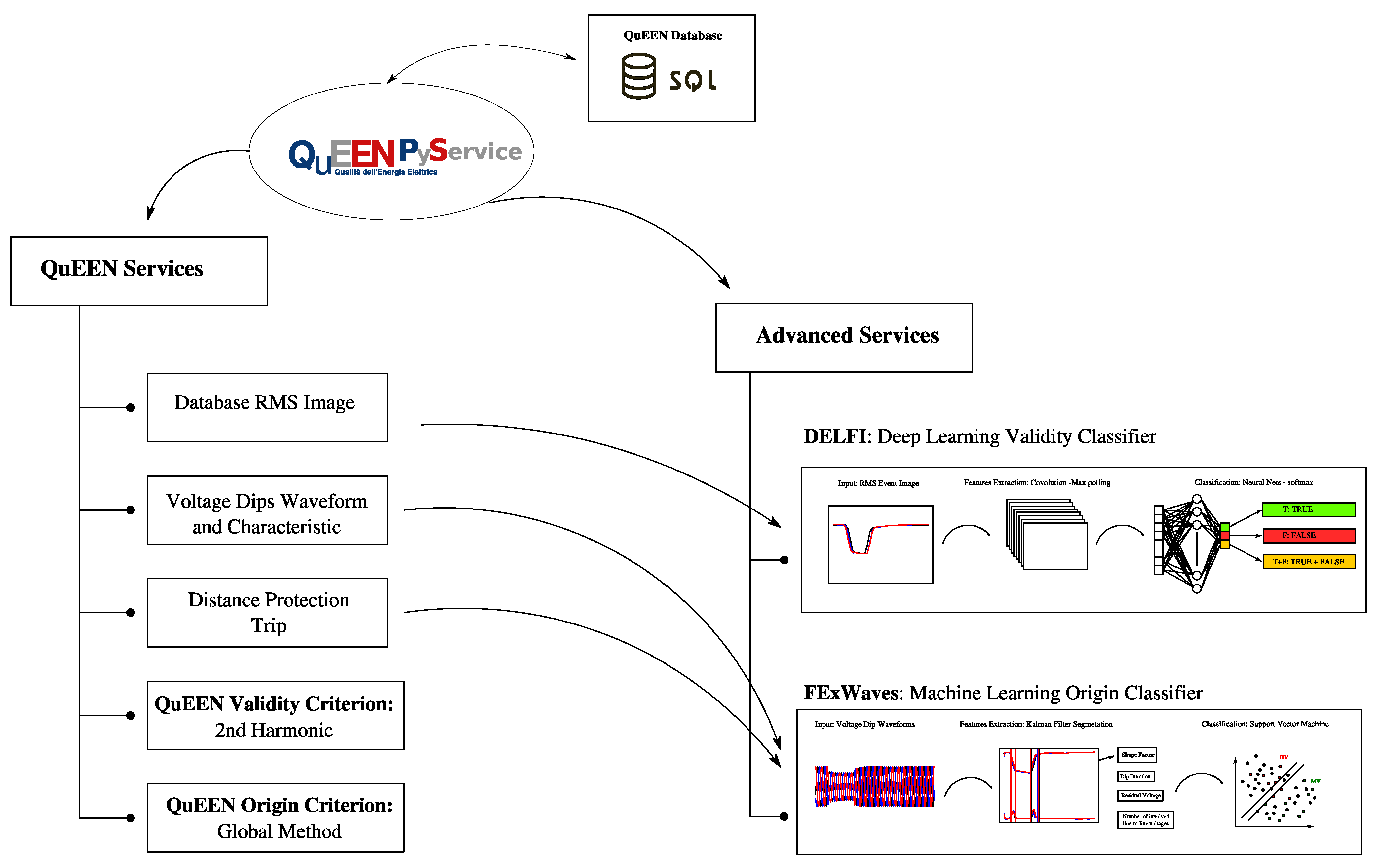
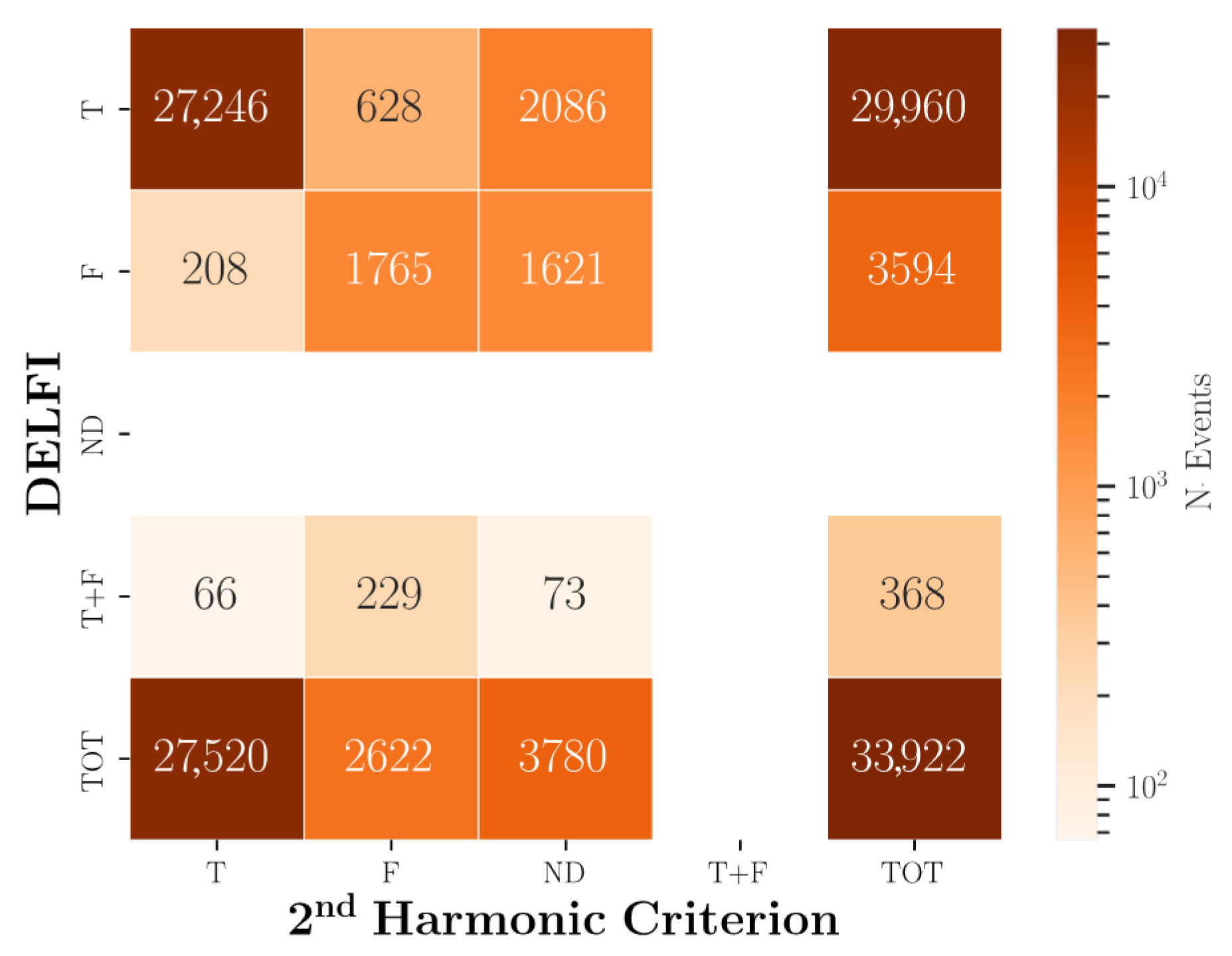
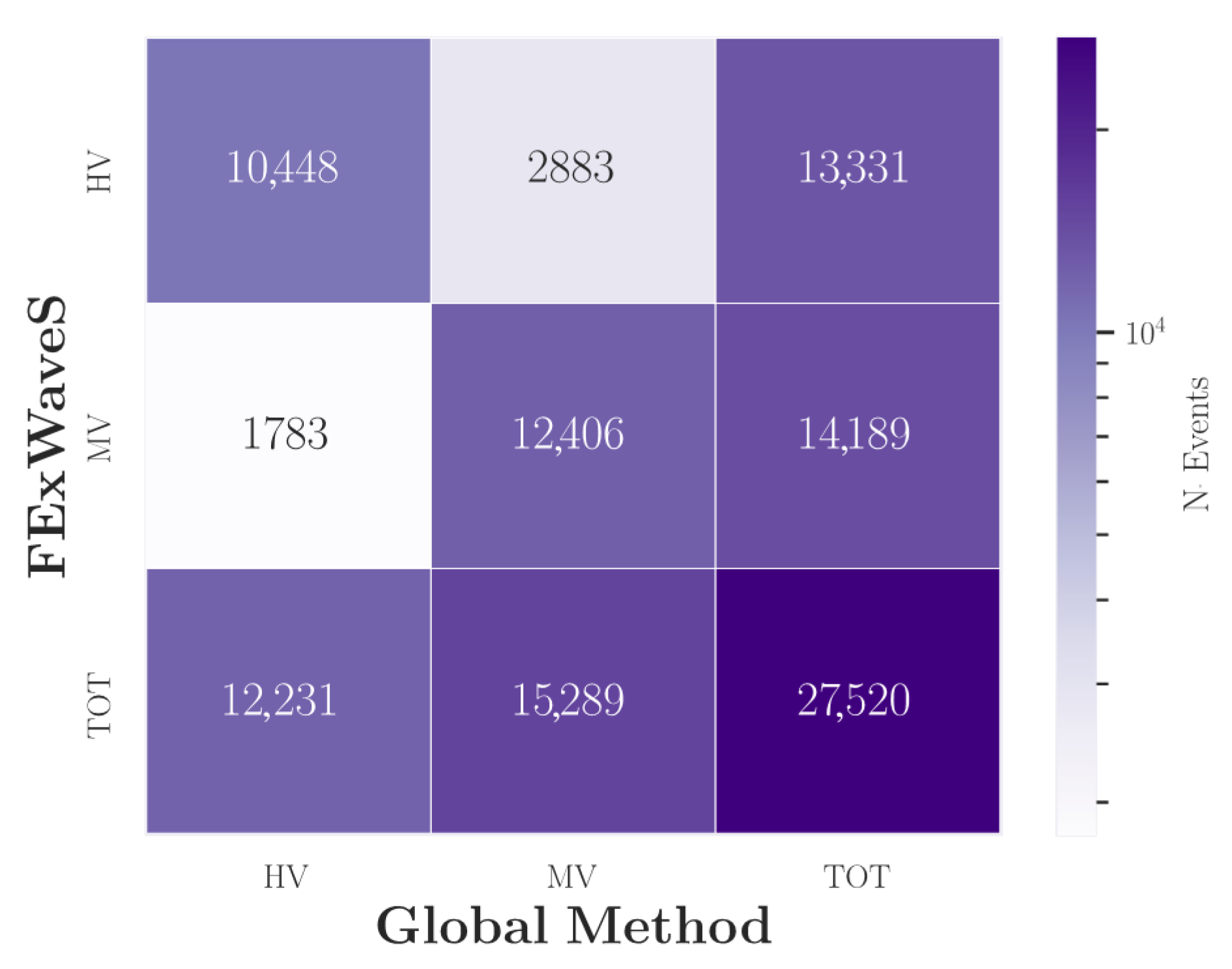
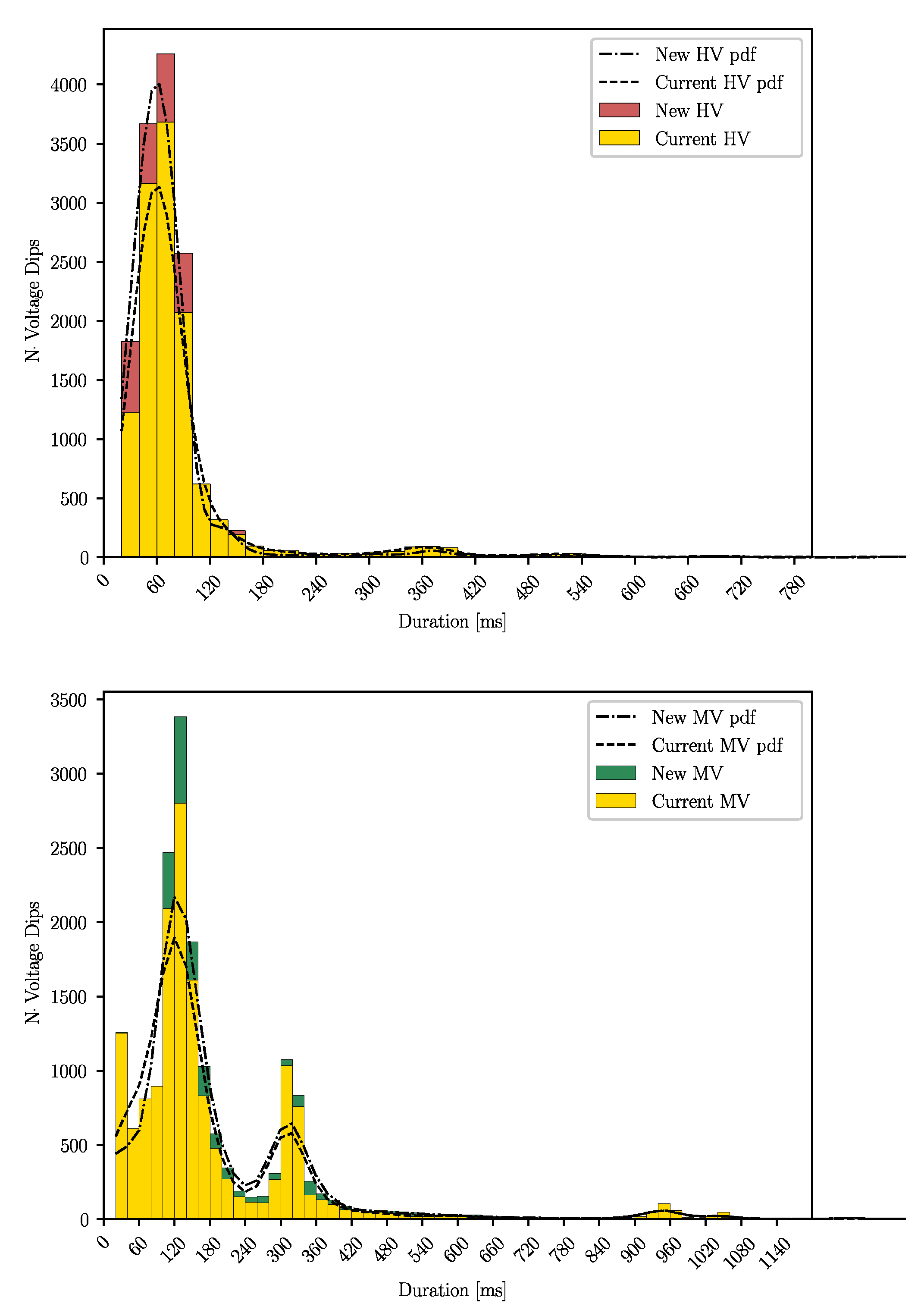
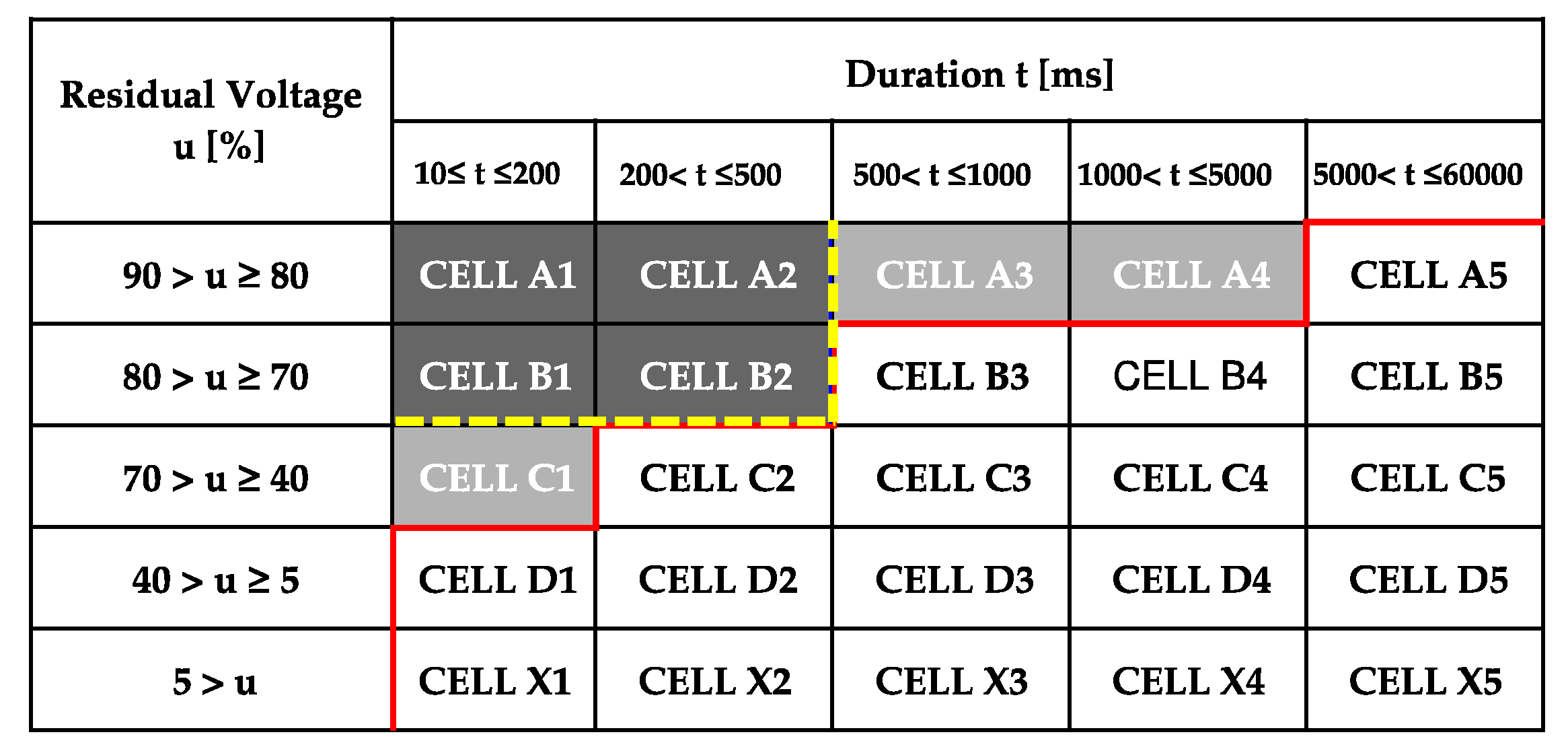
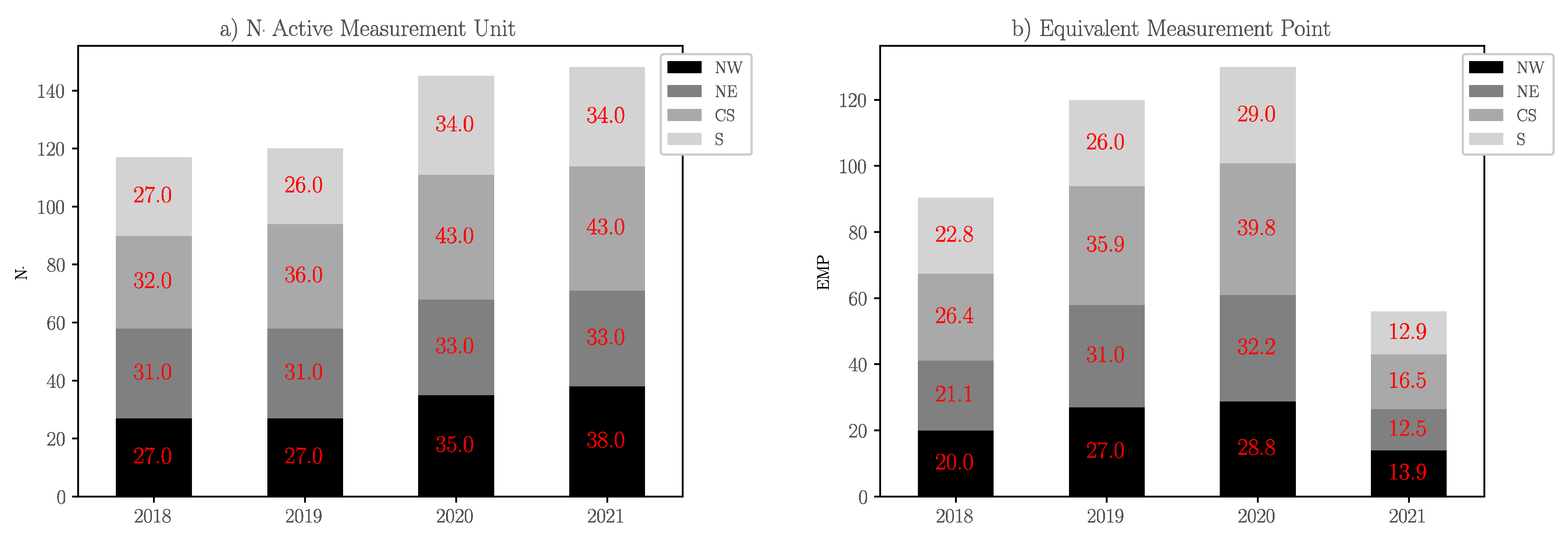

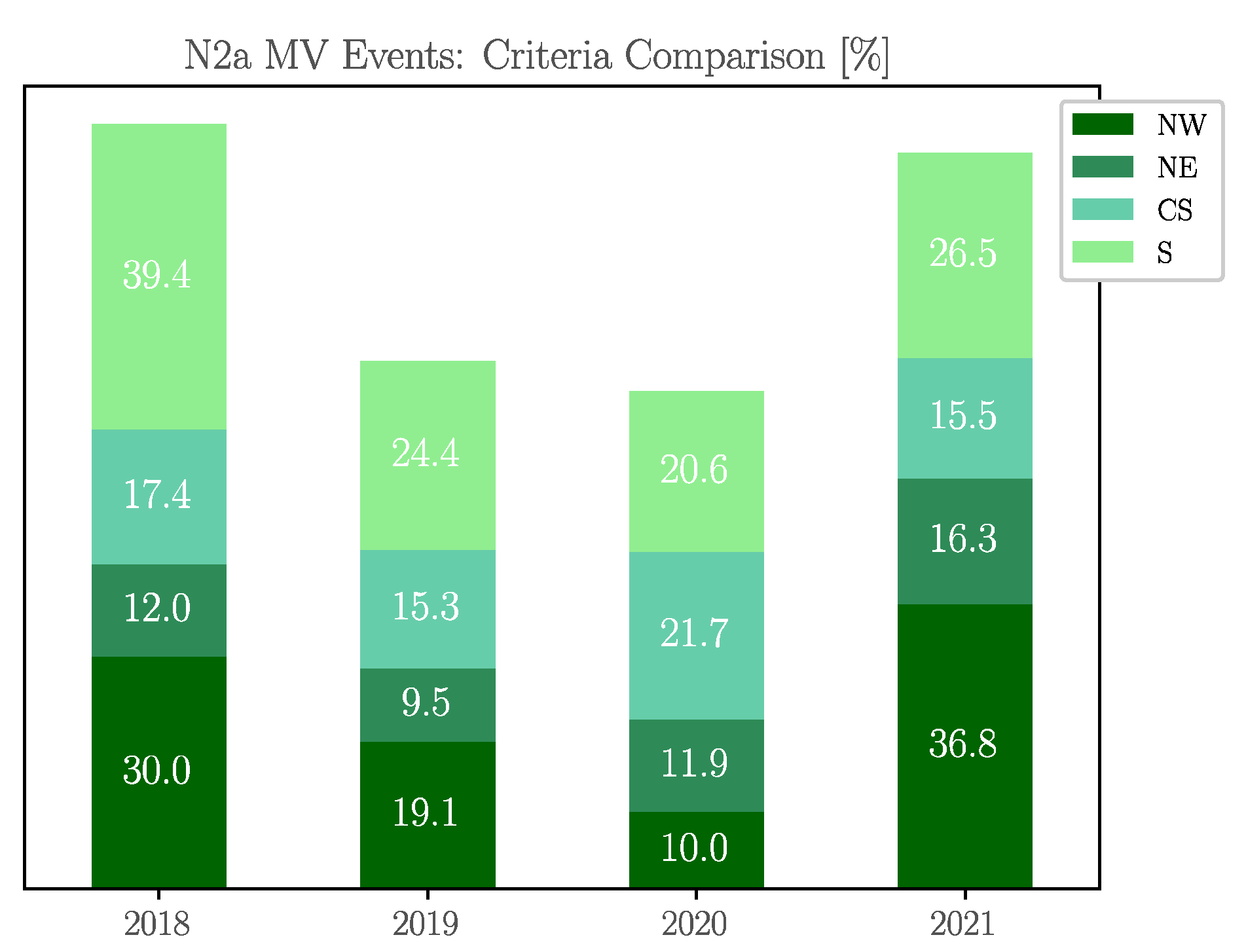
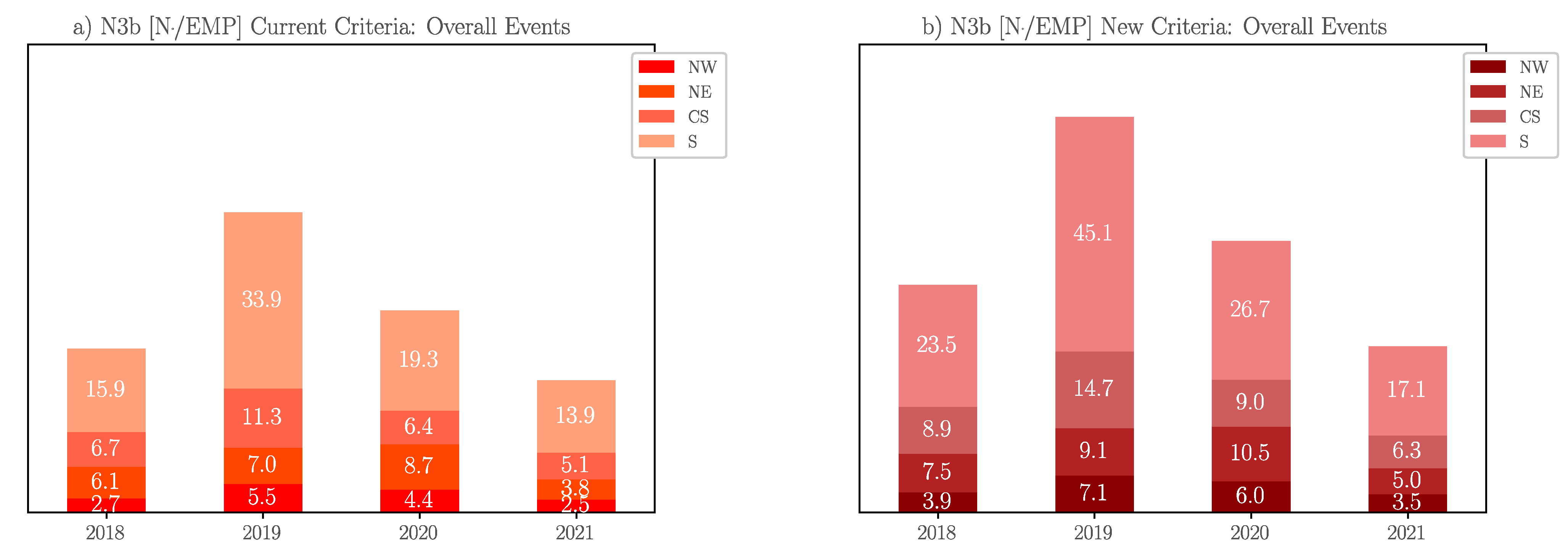
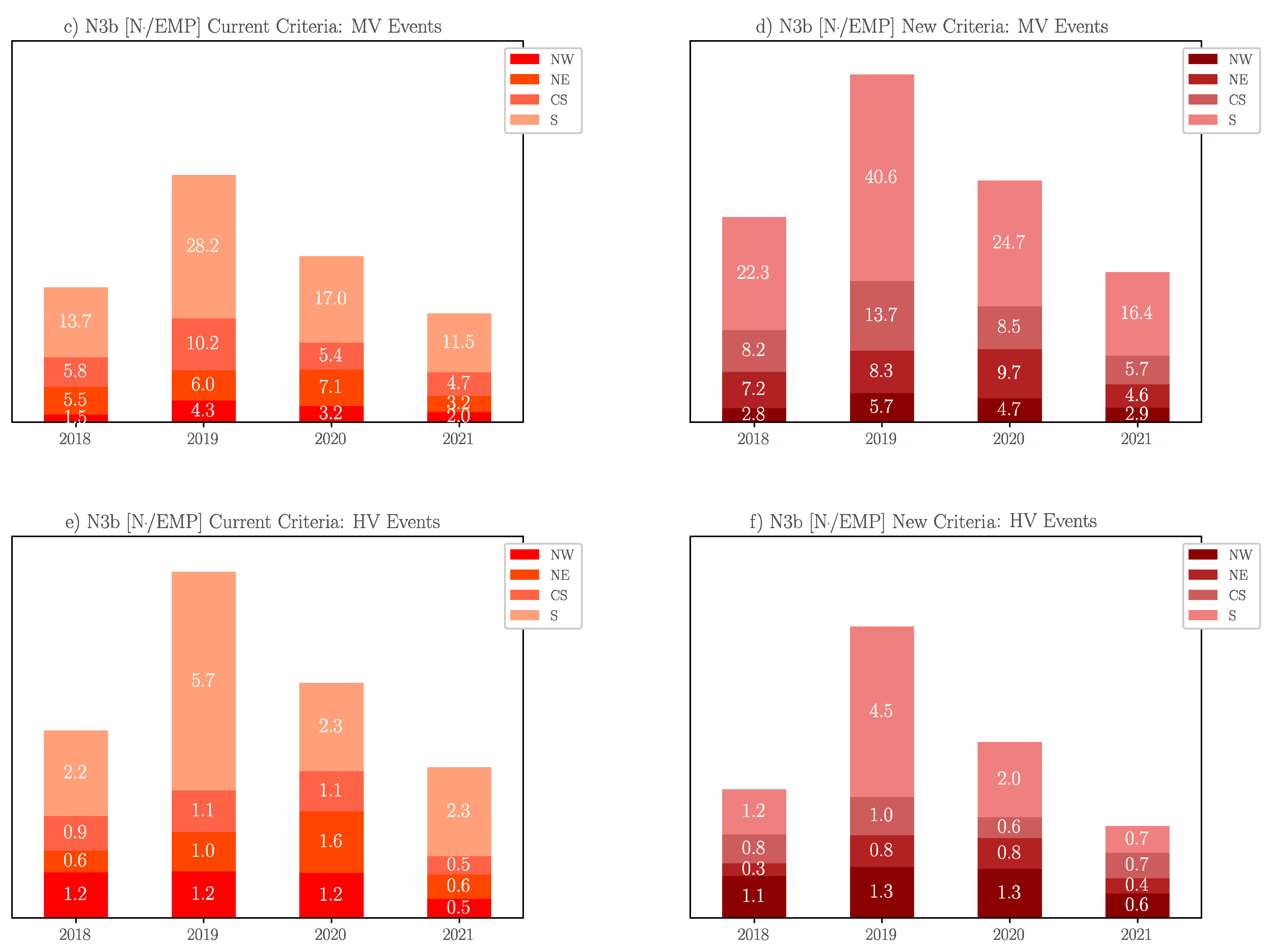
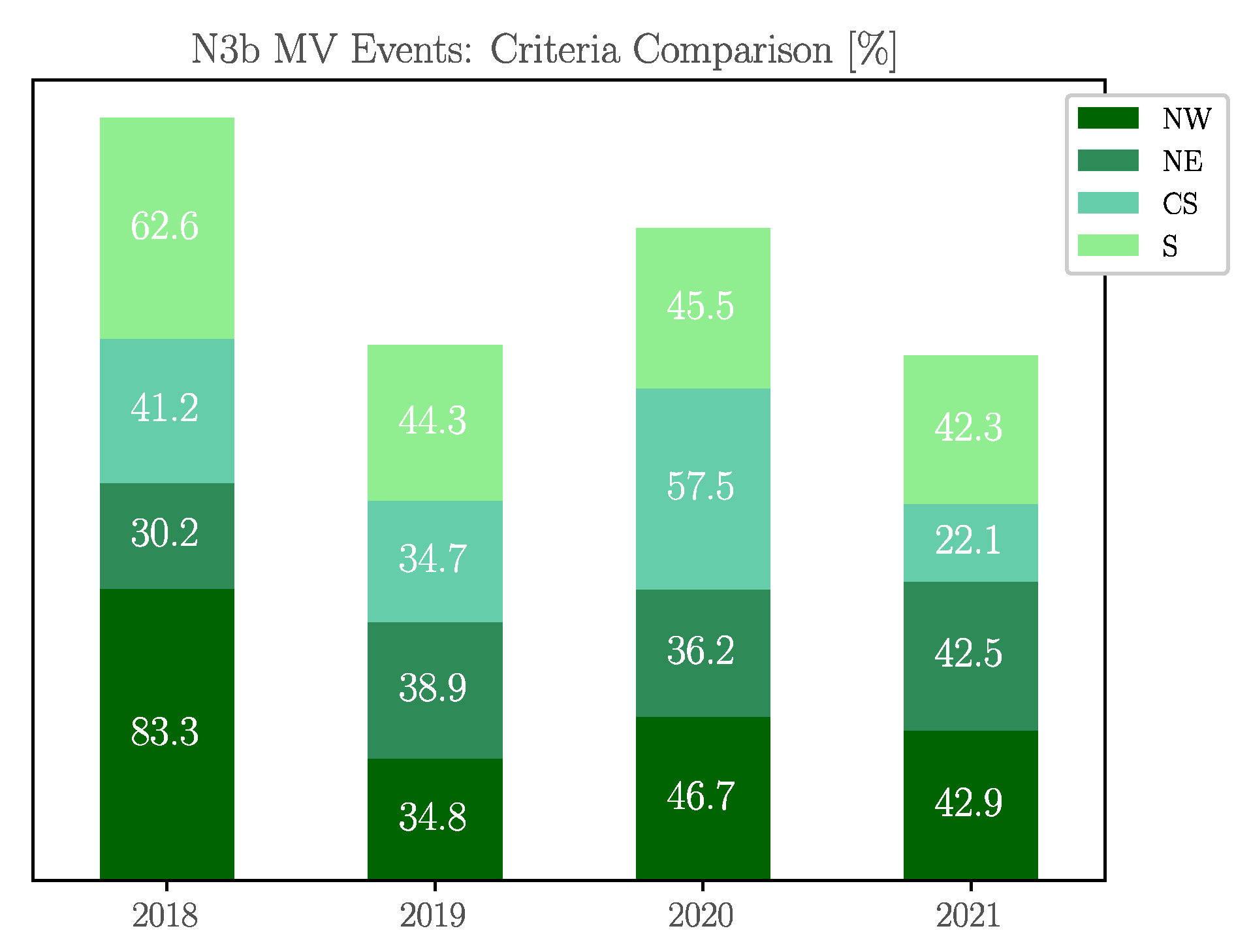
| Parameter | Value |
|---|---|
| CNN N° Layers | 1 |
| N° of Kernel Matrices | 63 |
| Mini-Batch Size | 33 |
| Learning Rate | 1.2 × 10−5 |
| Max-Epoch | 20 |
| Validity Criteria Consistency | 2nd Harmonic Criterion | ||||
|---|---|---|---|---|---|
| T [%] | F [%] | ND [%] | T+F [%] | ||
| DELFI | T [%] | 99.0 | 24.0 | 55.2 | - |
| F [%] | 0.8 | 67.3 | 42.9 | - | |
| ND [%] | - | - | - | - | |
| T+F [%] | 0.2 | 8.7 | 1.9 | - | |
| Criterion | T [%] | F [%] | ND [%] | T+F [%] |
|---|---|---|---|---|
| DELFI | 88.3 | 10.6 | 0 | 1.1 |
| 2nd Harmonic Criterion | 81.1 | 7.7 | 11.2 |
| Origin Criteria Consistency | Global Method | ||
|---|---|---|---|
| HV [%] | MV [%] | ||
| FExWaveS | HV [%] | 85.4 | 18.8 |
| MV [%] | 14.6 | 81.2 | |
| Methods | HV [%] | MV [%] |
|---|---|---|
| FExWaveS | 48.5 | 51.5 |
| Global Method | 44.5 | 55.5 |
| N° True Events | Current Criteria | New Criteria |
|---|---|---|
| 2018 | 5359 | 5837 |
| 2019 | 11,285 | 12,254 |
| 2020 | 8253 | 9017 |
| 2021 | 2288 | 2494 |
| N° True Events | Macro-Regional Areas | Current Criteria | New Criteria | Percentage Difference [%] |
|---|---|---|---|---|
| 2018 | NW | 776 | 838 | +8.0% |
| NE | 673 | 733 | +8.9% | |
| CS | 1384 | 1488 | +7.5% | |
| S | 2526 | 2778 | +10.0% | |
| 2019 | NW | 1070 | 1136 | +6.2% |
| NE | 1542 | 1717 | +11.4% | |
| CS | 2898 | 3158 | +9.0% | |
| S | 5775 | 6243 | +8.1% | |
| 2020 | NW | 1206 | 1289 | +6.9% |
| NE | 1436 | 1574 | +9.6% | |
| CS | 2118 | 2286 | +7.9% | |
| S | 3493 | 3868 | +10.7% | |
| 2021 | NW | 262 | 298 | +13.7% |
| NE | 232 | 254 | +9.5% | |
| CS | 711 | 768 | +8.0% | |
| S | 1083 | 1174 | +8.4% |
| N2a [N°/EMP] Overall Events | Current Criteria | New Criteria |
|---|---|---|
| 2018 | 21.3 | 25.7 |
| 2019 | 35.8 | 41.7 |
| 2020 | 25.3 | 29.9 |
| 2021 | 14.9 | 17.6 |
| N2a [N°/EMP] MT Events | Current Criteria | New Criteria |
|---|---|---|
| 2018 | 16.5 | 20.8 |
| 2019 | 28.0 | 33.3 |
| 2020 | 20.1 | 23.6 |
| 2021 | 10.7 | 13.1 |
| N2a [N°/EMP] AT Events | Current Criteria | New Criteria |
|---|---|---|
| 2018 | 4.8 | 4.9 |
| 2019 | 7.8 | 8.4 |
| 2020 | 5.2 | 6.3 |
| 2021 | 4.2 | 4.5 |
| Years | ΔN2a [%] |
|---|---|
| 2018 | +26.4 |
| 2019 | +18.8 |
| 2020 | +17.7 |
| 2021 | +22.9 |
| N3b [N°/EMP] Overall Events | Current Criteria | New Criteria |
|---|---|---|
| 2018 | 8.6 | 12.0 |
| 2019 | 14.8 | 19.5 |
| 2020 | 10.1 | 13.6 |
| 2021 | 6.7 | 8.4 |
| N3b [N°/EMP] MT Events | Current Criteria | New Criteria |
|---|---|---|
| 2018 | 7.3 | 11.1 |
| 2019 | 12.6 | 17.6 |
| 2020 | 8.5 | 12.4 |
| 2021 | 5.7 | 7.8 |
| N3b [N°/EMP] AT Events | Current Criteria | New Criteria |
|---|---|---|
| 2018 | 1.3 | 0.9 |
| 2019 | 2.3 | 1.9 |
| 2020 | 1.6 | 1.2 |
| 2021 | 1.0 | 0.7 |
| Years | ΔN3b [%] |
|---|---|
| 2018 | +52.1 |
| 2019 | +40.3 |
| 2020 | +46.1 |
| 2021 | +37.1 |
Publisher’s Note: MDPI stays neutral with regard to jurisdictional claims in published maps and institutional affiliations. |
© 2021 by the authors. Licensee MDPI, Basel, Switzerland. This article is an open access article distributed under the terms and conditions of the Creative Commons Attribution (CC BY) license (https://creativecommons.org/licenses/by/4.0/).
Share and Cite
Zanoni, M.; Chiumeo, R.; Tenti, L.; Volta, M. Advanced Machine Learning Functionalities in the Medium Voltage Distributed Monitoring System QuEEN: A Macro-Regional Voltage Dips Severity Analysis. Energies 2021, 14, 7949. https://doi.org/10.3390/en14237949
Zanoni M, Chiumeo R, Tenti L, Volta M. Advanced Machine Learning Functionalities in the Medium Voltage Distributed Monitoring System QuEEN: A Macro-Regional Voltage Dips Severity Analysis. Energies. 2021; 14(23):7949. https://doi.org/10.3390/en14237949
Chicago/Turabian StyleZanoni, Michele, Riccardo Chiumeo, Liliana Tenti, and Massimo Volta. 2021. "Advanced Machine Learning Functionalities in the Medium Voltage Distributed Monitoring System QuEEN: A Macro-Regional Voltage Dips Severity Analysis" Energies 14, no. 23: 7949. https://doi.org/10.3390/en14237949
APA StyleZanoni, M., Chiumeo, R., Tenti, L., & Volta, M. (2021). Advanced Machine Learning Functionalities in the Medium Voltage Distributed Monitoring System QuEEN: A Macro-Regional Voltage Dips Severity Analysis. Energies, 14(23), 7949. https://doi.org/10.3390/en14237949







